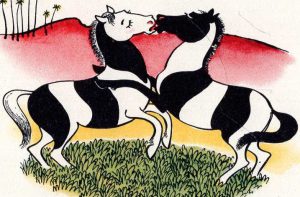White Collar – Variants
There is a high likelihood of variants in the 1st and 2nd editions. Any hand printed project of this magnitude can easily result in some pages out of order, upside down, or sideways.
The 1939 and 1940 editions of White Collar (160 and 300 copies respectively) were published by the artist, at home, with the help of his wife and children. Both editions have a printed page saying “A Home Made Book”.
If all the pages for the first edition were printed, waiting to be bound at one time, that would involve nearly 20,000 sheets of paper spread around the house. Anyone who has done much printing work (I assume he used some type of large platen press) will realize the logistical problems.
What was more typical of print artists with a large run, would be to print a batch and bind them, see how it goes with sales, etc and then print another batch. I have no information if this is what happened with White Collar.
Regardless of the process, one can expect to find variation in some of the image colours, the order of some pages might be scrambled, some pages may be bound in upside down, etc.
1st Edition cover image
- It has been suggested that some copies of the first edition were printed with a large collar and a miniature man either walking around inside or a miniature man escaping through gap in collar opening. Because these are all handmade books, it is very possible the artist tried different combinations of images on the cover – BUT
- the 5 copies of the 1st edition that I am aware of (#9, 57, 101,139, and 146) all have the same image on the cover – just a large collar with no man inside.
- If you have a copy of the 1st edition with a different cover image, please advise – not to be confused with the cover of the 2nd or 3rd editions showing a man with an oversized collar wrapped around his head.



Color of “Inner” Sequences


I have no information as to why Patri initially used gray ink for the protagonist’s inner feelings but changed to orange ink in later editions. My speculation is that the gray was not distinct enough from the black ink used for the rest of the images. Also Lynd Ward used orange ink for inner thoughts in 1932 for Wild Pilgrimage. Patri would have been aware of Ward’s usage.

Order of Pages
What is the definitive order of the images? This applies to different copies from the same edition as well as changes the artist decides to make from one edition to the next.
A handmade book can easily have slight variations in the order of the pages between copies from the same edition just due to human error. In addition, it sometimes happens that after a print run, the author can reflect on the book and, much like an editor, decide to change the order of some pages to make the story flow better. There could result in differences between the 1st and 2nd editions.
I would suggest either the 1940 Pisani publication or the 1975 Celestial be used as a reference point. Both of these were done by professional book publishers set up for larger print runs versus the scramble process of production in one’s home. In 1940 (and especially in 1975) Patri would have had the luxury of sitting back and examining each print and deciding on an order to best tell the story.
I have not done the painstaking work of flipping through each edition, comparing one to the other so I have no comment on the definitive order.
COMMENTS
If you disagree with something on this page, have an improvement, or have a comment please contact me
wn at wordlessnovels.com
Any information used will be given a credit line.

